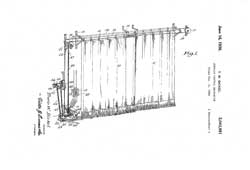Home >
Learning Zone > Introduction and Basics : The History of Electric Curtain Tracks
The History of Electric Curtain Tracks
The first record of curtains dates back to 3,100BC when the ancient Egyptians used animal hides to cover doors and windows.
The curtain was born.
Modern curtains as we know them in the UK have only been around since the 15th century.
Instead of wooden shutters, some rich person looking for a bit more flare in their country mansion decided some of the fancy, imported fabrics that covered their bed could be used to dress up their boring windows.
Innovation in the world of curtains was very slow. It took a couple of centuries to get to curtain poles and pelmets, and actual shaped curtain tracks with gliders are a very modern invention.
As fabrics became cheaper and more widely available, curtains were used in more and more places, including large ones on stages which were used to hide scene changes.
Initially, curtains were obviously all manual, requiring one or more people to pull the often heavy fabrics along.
The first upgrade from manual curtains saw them rigged with rope and pulleys so they could be operated from the stage wings. As with all new technology, it was only the wealthy institutions that could afford such luxuries.
 A 1934 electric curtain track design
A 1934 electric curtain track design
We searched through various patents and found a design for an electrically operated curtain track from 1934 (image shown): https://patents.google.com/patent/US2043981A/en
It took many years for pulley-operated curtains to find their way into residential homes, and then they were only in the homes of the wealthy.
1977 saw a patent by Michael S. Bochenek for an electrically operated curtain system: https://patents.google.com/patent/US4131831A/en
As with all technology, the idea of operating curtains electronically was an improvement over manually operated ones, as no physical labour was required and they moved at a constant, visually appealing speed.
Again, it took time for designs to be refined and the prices of parts to come down before electric curtains started making their way into residential homes.
Today, virtually everyone can have one or more high-quality Silent Gliss electric curtain tracks in their house, delivered to their door already at the right size to fit their windows.
Once curtains were controlled by a motor, different ways of operating the motor were developed.
We now have remote controls, wall-mounted switches and timers which simplify opening and closing your curtains.
It’s been quite a slow journey from those first ever curtains, but now you too can be part of the home-automation revolution!
< Back to the Learning Zone